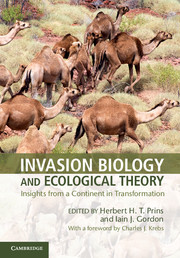Book contents
- Frontmatter
- Contents
- List of Contributors
- Foreword
- 1 Testing hypotheses about biological invasions and Charles Darwin’s two-creators rumination
- Part I Ancient invaders
- Part II Modern invaders
- 13 Invasion by woody shrubs and trees
- 14 Modern tree colonisers from Australia into the rest of the world
- 15 Failed introductions: finches from outside Australia
- 16 The skylark
- 17 Why northern hemisphere waders did not colonise the south
- 18 Weak migratory interchange by birds between Australia and Asia
- 19 Introducing a new top predator, the dingo
- 20 The European rabbit
- 21 The rise and fall of the Asian water buffalo in the monsoonal tropics of northern Australia
- 22 A critique of ecological theory and a salute to natural history
- Index
- References
19 - Introducing a new top predator, the dingo
from Part II - Modern invaders
Published online by Cambridge University Press: 05 February 2014
- Frontmatter
- Contents
- List of Contributors
- Foreword
- 1 Testing hypotheses about biological invasions and Charles Darwin’s two-creators rumination
- Part I Ancient invaders
- Part II Modern invaders
- 13 Invasion by woody shrubs and trees
- 14 Modern tree colonisers from Australia into the rest of the world
- 15 Failed introductions: finches from outside Australia
- 16 The skylark
- 17 Why northern hemisphere waders did not colonise the south
- 18 Weak migratory interchange by birds between Australia and Asia
- 19 Introducing a new top predator, the dingo
- 20 The European rabbit
- 21 The rise and fall of the Asian water buffalo in the monsoonal tropics of northern Australia
- 22 A critique of ecological theory and a salute to natural history
- Index
- References
Summary
Introduction
The introduction and establishment of the dingo Canis lupus Linnaeus; subspecies dingo was a landmark event in a long process of transformation of Australia’s assemblage of large mammalian carnivores, in which a diverse community of carnivorous marsupials was replaced by a simpler one dominated by invasive placental species. This chapter reviews current knowledge of that event. We discuss the interaction of the dingo with the Australian fauna and the reasons for its striking success on this continent, in relation to the 11 hypotheses that are addressed throughout this book. Because this case study is of a single species only, it has many idiosyncratic features and has little to say on some of these hypotheses. On the other hand, the history of the dingo is especially informative on several others.
The dingo closely resembles primitive domestic dogs that are still common in parts of southeast Asia and that were formerly more widespread in Asia (Corbett 2001; Irion et al. 2005). Evidence from mitochondrial DNA suggests that dingoes diverged from their Asian parent stock about 5000 years ago (Savolainen et al. 2004). This date is consistent with the first fossil appearance of dogs to the north of Australia in the archaeological records of Java, Timor and New Guinea between 5100 and 3000 years ago (Bellwood 1997; Bulmer 2001; Veth et al. 2005; O’Connor and Aplin 2007; Morwood et al. 2008; Sutton et al. 2009). Dingoes appear in the Australian fossil record soon after 3500 years ago: the three earliest dates are 3450, 3230 and 3170 years BP, from, respectively, Madura Cave on the Nullarbor Plain in Western Australia (Milham and Thompson 1976), Wombah Midden in eastern New South Wales (McBryde 1982), and Fromm’s Landing in southeast South Australia (Mulvaney et al. 1964).
- Type
- Chapter
- Information
- Invasion Biology and Ecological TheoryInsights from a Continent in Transformation, pp. 414 - 428Publisher: Cambridge University PressPrint publication year: 2014

